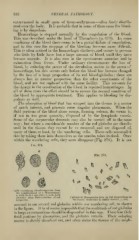Page 676 - My FlipBook
P. 676
686 GENERAL PATHOLOG Y.
extravasatecl in small spots of tissue-ecchymoses—often freely distrib-
uted over the body. It is probable that in some of these cases the bleed-
ing is by diapedesis.
Hemorrhage is stopped naturally by the coagulation of the blood.
This was described under the head of Thrombosis (p. 679). In some
conditions of the blood there seems to be a partial failure of coagulation,
and in this case the stoppage of the bleeding becomes more difficult.
This is often noticed in the hemorrhagic diathesis, and occurs in persons
who little by little have lost a large amount of blood, until they have
become ansemic. It is also seen in the spontaneous anseniias and in
exhaustion from fevers. Under ordinary circumstances the loss of
blood, by reducing the power of the circulation, assists in the arrest of
hemorrhage, but this occurs only before the blood has become changed
by the loss of a large proportion of its red blood-globules ; these are
always lost in greater proportion than the other constituents of the
blood, and are not replaced with the same facility. This accounts for
the change in the constitution of the blood in repeated hemorrhages. In
all of these cases the eflPort should be to restore the normal condition of
the blood by appropriate treatment. This applies to bleeding by dia-
pedesis as well.
The absorption of blood that has escaped into the tissues is a matter
of much interest, and presents some singular phenomena. When the
fluid portions of the blood alone escape, forming oedema, the serum is,
if not in too great quantity, disposed of by the lymphatic vessels.
Some of the corpuscular elements may also be carried off in the same
way ; but where a considerable number of the red globules are distrib-
uted in the tissues they cannot be so removed, and are disposed of,
many of them at least, by the wandering cells. These cells accomjilish
this by taking them into themselves as the amoeba takes its food. Once
within the wandering cells, they soon disappear (Fig. 378). It is not
Fig. 378.
Fig. 379.
Cells containinK Blood-corpuscles from
the neighborhood of a lleinorrhage:
a, with fresh corpuscles ; b, with dark
granules from disintegration of red
corpuscles.


